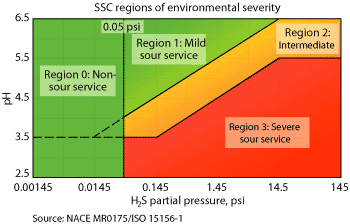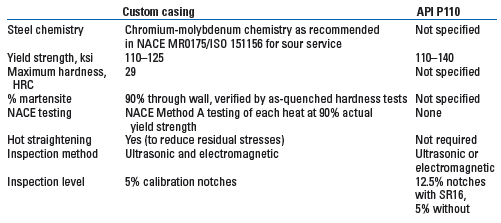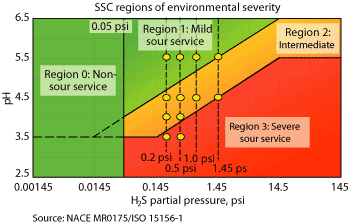A custom 110-ksi pipe grade enabled an East Texas operator to drill and complete wells in the presence of H2S without resorting to costly C110 or T95 casing.
Mike Chaffin, Valence Operating Company; Garth Lynn and Bruce Bradley, V&M Tubes
In 2007, a Texas-based independent operator needed a 110-ksi pipe grade specifically designed for mild sour service in the company’s large-scale drilling program in Leon County, Texas. The challenge was to develop a 110-ksi product that would be suitable for wells with the potential to develop a mildly sour environment, but without incurring the high cost of going to a C110 or T95 product. A customized 110-ksi product grade was developed for this application, consistent with all industry requirements, and the operator began using the new pipe grade in 2007, resulting in major cost savings.
INTRODUCTION
The tubulars used in drilling and completing oil and gas wells not only constitute a major portion of the operator’s total well cost, but also are critical components in the successful completion of the well. Consequences from a failed casing string can range from additional costs for salvaging the well to total loss of the well, and possibly environmental damage.
One variable that must be carefully considered is the potential presence of and concentration of hydrogen sulfide. Exposure to H2S, particularly at lower temperatures and pH levels, can lead to Sulfide Stress Cracking (SSC) and catastrophic failure of the casing string. Figure 1 shows an example of such catastrophic failure: the cracking of API 8rd and buttress connections due to the combination of high internal hoop stresses from makeup and exposure to low to moderate levels of H2S. Fields such as the Deep Bossier, Wilcox Trend and Permian Basin in Texas, as well as new plays such as the Bakken Shale of Montana, North Dakota and Saskatchewan, contain varying levels of H2S that must be addressed.
 |
|
Fig. 1. Exposure to H2S can lead to Sulfide Stress Cracking (SSC), such as seen here in an API 8rd connection.
|
|
In many areas, H2S concentrations in gas-bearing formations are minor, as low as a few parts per million. However, with high initial flowing pressures, this minor concentration of H2S exceeds 0.05-psi partial pressure, which NACE Standard MR0175, “Sulfide stress corrosion cracking resistant metallic materials for oil field equipment,” cites as the limit for safe service using API P110-grade casing. Additionally, there is the potential for “slight” souring over the life of the well. The alternative to P110 casing when this limit is exceeded is to use sour-grade casing such as T95 or C110. These grades can be used in the most severe H2S-containing environments; however they generally require longer lead times and are only available from a few suppliers.
NACE MR0175 was revised in 2004-2005 to include the possibility of performing fit-for-purpose testing to qualify a material for a given application. If proper testing of the P110 grade proves the pipe grade able to withstand low amounts of H2S in a laboratory setting, then NACE MR0175 considers P110 acceptable for use up to the tested limits.
Valence Operating Company, an operator with a large drilling program of more than 50 wells in Leon County, Texas, experienced 8-10 ppm H2S with flowback pressures as high as 9,500 psi. These wells were stimulated via a high-pressure water fracture treatment down casing and flowed back up the casing for several months before tubing was run. The casing strings were therefore exposed to up to 0.08-psi partial pressures of H2S for a few days or weeks before pressures dropped, reducing the load below 0.05-psi partial pressure. Due to this short-lived but potentially damaging H2S environment, 7-in., 32.0 lb/ft C110 was selected to handle the fracturing treatment and flowback in these wells.
‘OFF THE RACK’ P110 TESTING
NACE MR0175/ISO 15156-2 allows the use of API P110 for sour applications with temperatures of 150°F or greater. While downhole temperatures may often exceed this temperature during production, SSC can occur during short exposures to lower-temperature H2S during shut-in periods. Appendix B of the industry standard also provides recommendations for qualifying materials for a specific application by performing laboratory testing at H2S partial pressures appropriate to the intended application.
Once it was determined that NACE MR0175 allowed the laboratory testing and use of P110 casing for this environment, Valence Operating Company began investigating the possibility of taking P110 out of existing inventory and performing a modified H2S NACE test to qualify the casing for the application. The advantages of qualifying P110 were obvious. The long lead time for C110 casing to be manufactured would be eliminated. The cost of “off the rack” P110 was considerably less expensive and could provide more flexibility in the drilling schedule, since the pipe could be made available with shorter lead times.
In 2005, Valence designed a procedure to test representative samples of P110 inventory in pipe yards to determine their suitability for use. First, mill certificates were reviewed for hardness and yield strength. Pipes were selected from heats with higher hardness values, and four random samples were taken from each heat. A laboratory was selected to test the samples in a 30-day NACE Method A test with a modified environment. The modified environment chosen to test the pipes had a 0.09-psi partial pressure H2S phase and a pH of 3.0. During this period, material from three separate mills were tested successfully and used in wells without failure.
While the testing of existing P110 inventory to determine fit for purpose was successful, there are some risks associated with qualifying existing inventory. First, there is no maximum hardness or hardness testing requirement for API P110, so there is no hardness control during production, or any data for the hardness on individual joints. Secondly, API P110 is not produced as a sour service grade, so production operations do not include process controls normally used for sour service materials. For example, cold rotary straightening without thermal stress relief is permitted for API P110, while sour service grades require either hot rotary straightening or stress relief after cold rotary straightening.
CUSTOM CASING GRADE
During this time, one of the mills tested, V&M Star, approached Valence to propose a 110-ksi pipe grade specifically designed for mild sour service. The new pipe grade would be tested to meet the entire Region 1 of the NACE chart for sour service severity, Fig. 2.
 |
|
Fig. 2. MR0175/ISO 15156 SSC regions of environmental severity.
|
|
The challenge was to develop a 110-ksi product that would be suitable for wells with the potential to develop a mildly sour environment, but without incurring the significant cost of going to a C110 or T95 product. V&M Star began development of a fit-for-purpose grade that could be qualified up to 0.20 psia H2S at a pH of 5.5.
The new product grade, VM P110 MS, was developed in a manner that is consistent with the requirements of the NACE specification for NACE MR0175/ ISO 15156, “Petroleum and natural gas industries: Materials for use in H2S-containing environments in oil and gas production.” Additionally, the product was designed to meet all of the requirements of API 5CT/ISO 11960 2004, grade P110. The result was a product that meets all the requirements of API P110, and also provides NACE-tested resistance to SSC. Table 1 shows some specific attributes of the custom product grade compared with API P110.
| TABLE 1.Attributes of the custom product grade compared with API P110 |
 |
|
The initial trials and NACE testing were performed on seven lots of 7-in. 32.0-lb/ft casing, followed by 11 additional lots. No casing from any of the 20 lots experienced failure. The NACE testing consisted of a set of three Method A tests from each lot, tested in the Valence fit-for-purpose solutions. Since the initial trials, the custom grade has been produced and NACE tested as 7-in. 29.0-lb/ft (12 lots), 5½-in. 20.0-lb/ft (2 lots), and 5-in. 23.2-lb/ft (15 lots), all without any failures. All of these sizes have been NACE tested in various solutions, with no discernable effect related to the pipe size. Coupling stock has also been produced and NACE tested for both premium and API connections.
The specific operational environment provided by Valence fell into NACE Sour Service Environmental Severity Region 1 (mildly sour). To date, more than 50 lots have been NACE Method A tested in this Valence fit-for-purpose solution without a failure. To provide additional information regarding the material’s SSC resistance, Method A testing has also been performed in other, more severe solutions in NACE Regions 1, 2 and 3, Fig. 3. Eight or more lots have been tested in each of these additional environments, with all of the samples passing Method A testing.
 |
|
Fig. 3. NACE testing points passed with the custom P110 casing grade.
|
|
To provide additional assurance, the custom grade was tested with the sample stressed to 90% of each heat’s actual material yield strength. Many grade specifications only require stressing the samples to 80 or 90% of the material’s specified minimum yield strength.
Although the custom casing grade passed NACE Method A testing in points of Regions 2 and 3, it is recommended for use in Region 1 (mildly sour) environments only. T95 and C110 should still be used in a Region 2 (intermediate) or Region 3 (severely sour) environment.
OPERATOR APPLICATION
Before the development of the custom casing grade, from 2003 to early 2006, Valence had completed 17 wells using only C110 for the company’s 7-in. production casing. Based on in-house testing of inventoried P110, the operator was able to change to the “qualified” P110 for five wells in 2006. In 2007, once the qualification of the new, custom casing grade was completed, Valence began using it. Valence has ceased testing existing P110, and by the end of 2008, six wells will be completed using the new custom grade, in 7-in. and 5½-in. sizes, as the production casing.
By switching from C110 first to “qualified” P110 and then to the new custom P110 grade, Valence has achieved an approximate savings of $108,000 per well for the first 13 wells, resulting in a total savings to date of $1.4 million. With increased tubular costs and more than 40 more wells planned in Farrar Field in Leon County, Texas, an additional savings of $6 million is expected from switching from C110 and T95 to the custom P110 grade for mild sour applications.
RESULTS
Several benefits were realized by the operator. First, Valence would not have to perform material testing and qualification. Even with previous API P110 NACE testing, the mills would not warrant the materials for SSC resistance. This placed the risks of using standard P110 in even a mildly sour environment totally on the operator. The chromium-molybdenum custom grade, however, was guaranteed to pass NACE testing in all of Region 1.
Also, material tracking and inventory would be less complicated. Segregation of pipe into tested and untested stock would no longer be required, making storage and handling simpler. Also, the risk of shipping untested material to the rig is greatly reduced since the custom grade designation is identified in the mill stencil as well as with specific grade paint bands.
Another significant benefit was the larger operating envelope. Instead of being tested at specific points, the custom grade was tested and passed at points more severe than Region 1 applications, providing a larger safety window than with standard API P110 tested at specific points.
More stringent mill inspection of the custom-grade finished tubes provided another advantage to the operator. The finished tubes are inspected with two non-destructive, full-length inspections: ultrasonic and electromagnetic. These units are calibrated with OD and ID notches machined to 5% of the nominal pipe wall thickness instead of the 12.5% for API P110, making the inspection units more sensitive and reducing the risk of failing to detect injurious tube defects. The custom casing grade is also manufactured as API Product Specification Level (PSL) 2 instead of the standard PSL 1. This provides another level of confidence for the operator, particularly in critical applications and mildly sour wells. 
|
THE AUTHORS
|
| |
Mike Chaffin is the drilling department manager for Valence Operating Company in Houston. Before joining Valence in 1996, Mr. Chaffin worked as a drilling engineer and manager in the US and internationally, including a two-year rotational assignment into Kazakhstan. He holds a BS degree in petroleum engineering from the University of Missouri-Rolla. Mr. Chaffin can be contacted at mchaffin@valenceoperating.com.
|
|
| |
Garth Lynn is the senior metallurgist at V&M Star’s Youngstown, Ohio, facility. He has been with North Star Steel and V&M Star for a total of 17 years in various process, product and R&D metallurgical positions. Mr. Lynn holds a BS degree in metallurgical engineering from The Ohio State University. He can be contacted at glynn@vmstar.com.
|
|
| |
Bruce Bradley is the marketing and technical sales/service manager for V&M Tubes in Houston. He holds a BS in mechanical engineering from the University of Houston and has over 30 years’ experience since 1976 in manufacturing, R&D and applications of oilfield tubulars and premium threaded connections. Mr. Bradley can be contacted at bruce.bradley@vmtubes.com.
|
|
|






